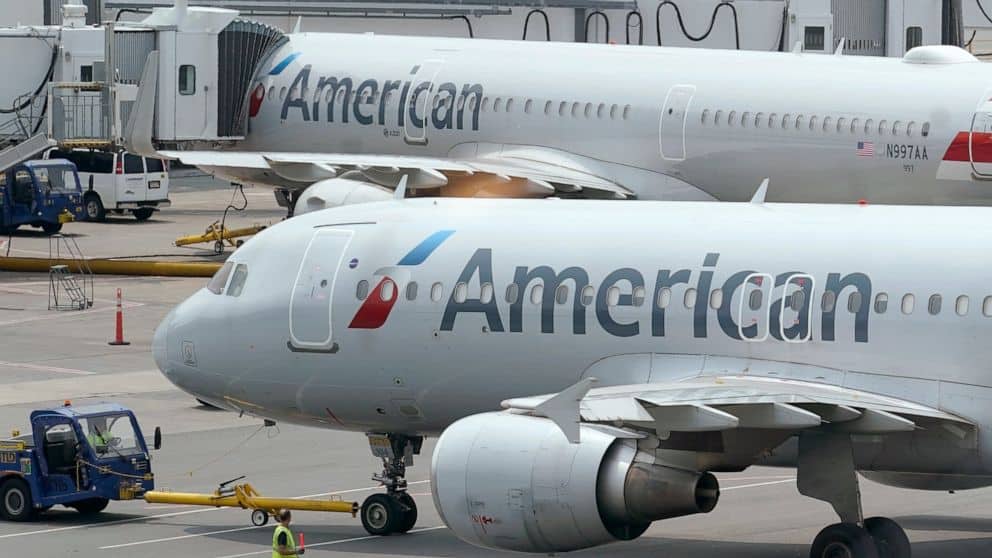DALLAS — U.S. airlines say they have hit a turning point: After a lousy first quarter, they expect to be profitable as Americans return to travel in the biggest numbers since the start of the pandemic.
American Airlines is the latest carrier to give a rosy outlook for the rest of 2022. American said Thursday that although it lost $1.64 billion in the first quarter, sales hit a record in March, and the company expects to earn a profit in the second quarter.
“Demand is as strong as we have ever seen it,” American CEO Robert Isom told analysts.
American’s upbeat view echoed similar comments from Delta Air Lines and United Airlines, which both predicted in recent days that they will earn full-year profits despite big losses in the first quarter.
Air travel was subdued in January and February by the omicron variant that caused an increase in COVID-19 cases among both travelers and airline employees. But travelers came back in March, and airline executives believe that Americans are eager to travel this summer and won’t be discouraged by another, smaller uptick in coronavirus cases and higher airfares.
Industry officials attribute rising airfares to a combination of covering higher fuel costs, a limited number of flights compared with schedules before the pandemic, and strong demand.
“We are encouraged that indeed month to month we are seeing a greater increase in fares,” said Vasu Raja, American’s chief commercial officer. “We are seeing a lot of strength in the fare environment.”
The recovery is being powered by leisure travelers, but the airlines say they are seeing more business travelers.
American said overall business travel is 80% of pre-pandemic levels, dragged down by corporate travel, which is only 50% of 2019 levels. Isom said, however, that corporate bookings are the highest they have been since the start of the pandemic, “and we expect that to continue as more companies reopen their offices.”
Along with higher revenue, however, airlines face higher costs for fuel and labor. American’s fuel bill more than doubled from a year earlier, and payroll costs rose more than 15%.
Airlines struggled with a nascent recovery in travel last summer, as understaffing contributed to thousands of canceled flights. Now, facing a much bigger boom — the number of people going through checkpoints at U.S. airports is up more than 50% from a year ago to 2.1 million a day in April — it’s unclear whether airlines have done enough hiring to avoid bigger disruptions this summer.
A major challenge will be the limited supply of pilots, which could limit the ability of airlines to operate as many flights as they would like.
“The pilot shortage for the industry is real, and most airlines are simply not going to be able to realize their capacity plans because there simply aren’t enough pilots, at least not for the next five-plus years,” United CEO Scott Kirby told analysts Thursday.
American said it has hired 1,100 pilots since the start of last year. Many of those came from smaller, regional airlines, leaving those carriers with shortages. As a result, American will trim its American Eagle schedule in the second quarter.
American’s passenger-carrying capacity will also be lower than planned because deliveries of new Boeing 787 jets have been delayed by production problems at Boeing factories.
Isom said American will adjust its schedule to match the number of available planes and pilots. He said American executives “have tremendous confidence” that the airline will operate smoothly through the summer.
American reported a bigger first-quarter loss than a year ago, when it lost $1.25 billion. The Fort Worth, Texas-based airline said that excluding special items it lost $2.32 a share, slightly better than the average forecast of an adjusted loss of $2.43 per share, according to a Zacks Investment Research survey. Revenue rose to $8.9 billion.
Alaska Air Group, the parent of Alaska Airlines, said Thursday that it lost $143 million in the first quarter, compared with a $131 million loss a year earlier. Revenue more than doubled to $1.68 billion but was down 10% from the same quarter in 2019.
The Seattle-based carrier forecast that second-quarter revenue will be 5% to 8% higher than in the same quarter of 2019.
After the market closed on Thursday, Chicago-based United Airlines Holdings reported Wednesday a $1.38 billion loss for the first quarter but said it expects to return to profitability in the April-to-June quarter. Revenue of $7.67 billion was up from a year ago but down 21% from early 2019, as the airline continues to run fewer flights than before the pandemic.
Shares of United rose 9% by the closing bell, while American gained 4%, Delta Air Lines added 3%, and Alaska was little changed.

